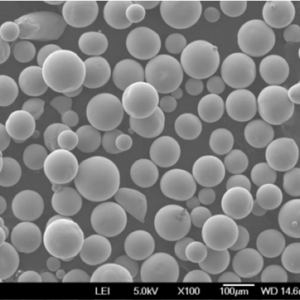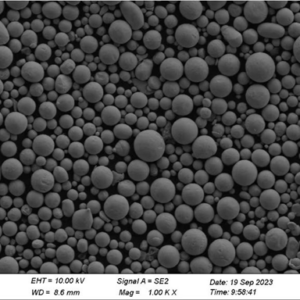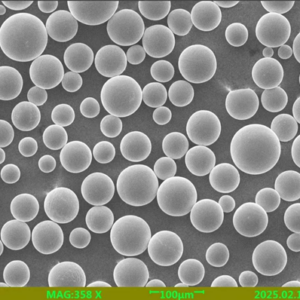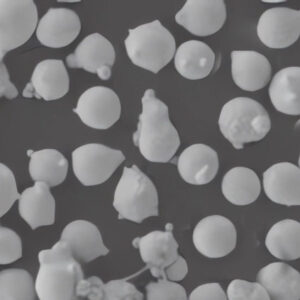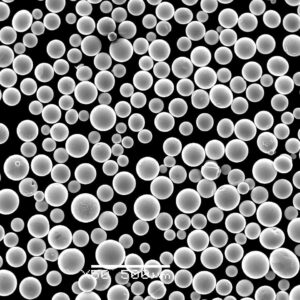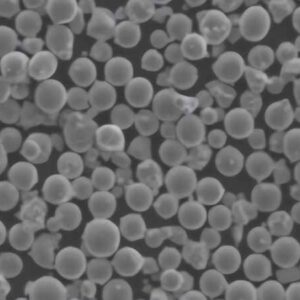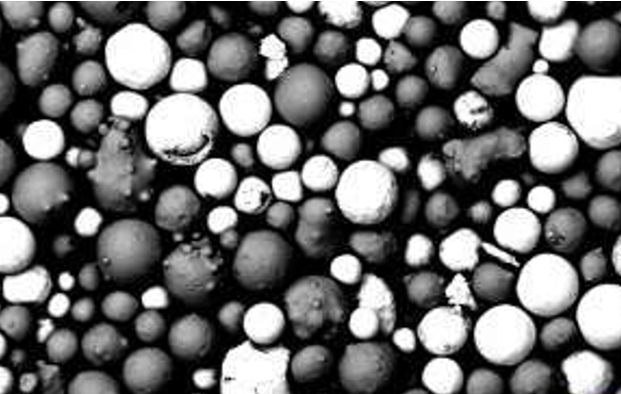Imagine building complex, lightweight structures with the strength of machined aluminum. That’s the magic of Al 6061 powder, a game-changer in the world of additive manufacturing, also known as 3D printing. But what exactly is this innovative material, and how does it revolutionize manufacturing? Buckle up, because we’re diving deep into the fascinating world of Al 6061 powder!
Introduction to Al 6061 Powder
Al 6061 powder is a metal powder specifically designed for additive manufacturing processes like Selective Laser Melting (SLM) and Direct Energy Deposition (DED). It’s made from the ever-reliable 6061 aluminum alloy, a workhorse material known for its excellent balance of strength, weight, and machinability. But how do they transform solid aluminum alloy into a powder suitable for 3D printing?
Production Methods of Al 6061 Powder
There are two main methods for creating Al 6061 powder:
- Gas Atomization: This high-tech process involves molten aluminum being injected into a high-pressure inert gas stream. The rapidly cooling droplets solidify into tiny, near-perfectly spherical particles – ideal for smooth and consistent 3D printing.
- Water Atomization: Similar to gas atomization, molten aluminum is forced through a high-pressure water jet. The resulting particles tend to be less spherical but offer a more cost-effective alternative.
The choice of method depends on the desired particle size, shape, and overall cost. Regardless of the method, the resulting Al 6061 powder undergoes rigorous quality control to ensure consistent flow, optimal packing density, and minimal impurities for successful 3D printing.

the Composition and Properties of Al 6061 Powder
So, what makes Al 6061 powder tick? Let’s break down its key ingredients and characteristics:
- Composition: Primarily aluminum (around 95.5-98.5%), with magnesium (0.8-1.2%) and silicon (0.5-0.7%) as the main alloying elements. These elements work together to enhance the strength and workability of the base aluminum.
- Properties: Here’s where the magic happens:
- High Strength: Al 6061 powder boasts excellent strength-to-weight ratio, making it ideal for applications demanding both lightness and structural integrity. Imagine creating complex aircraft parts without compromising on performance!
- Good Corrosion Resistance: Similar to its bulk counterpart, Al 6061 powder offers decent resistance to corrosion, making it suitable for various environmental conditions.
- Excellent Machinability: Need to fine-tune a 3D-printed part? No problem! Al 6061 powder retains the excellent machinability of the original alloy, allowing for post-processing and customization.
- Weldability: Joining 3D-printed components? Al 6061 powder offers good weldability, making it a versatile choice for complex structures.
Key takeaway: Al 6061 powder inherits the best qualities of its parent alloy – strength, weight efficiency, corrosion resistance, and excellent workability – making it a top contender for various 3D printing applications.
the Applications of Al 6061 Powder
The possibilities with Al 6061 powder are truly endless. Here are some prominent application areas:
| Application Areas |
|---|
| Aerospace: From lightweight aircraft components like brackets and wing ribs to complex engine parts, Al 6061 powder is revolutionizing aerospace design. Its strength-to-weight ratio allows for significant weight reduction without compromising on structural integrity, a crucial factor for fuel efficiency and flight performance. |
| Automotive: The automotive industry is embracing Al 6061 powder for components like custom brackets, lightweight wheels, and even some engine parts. The ability to create complex, high-strength structures with minimal weight opens doors for improved fuel efficiency and overall performance. |
| Consumer Electronics: The world of gadgets is getting a boost from Al 6061 powder. Imagine lightweight yet sturdy laptop chassis, intricate camera components, or even customized heat sinks – the possibilities are vast! |
| Medical Devices: Al 6061 powder’s biocompatibility makes it a potential candidate for creating custom prosthetics and implants. The ability to tailor components to individual needs with 3D printing paves the way for advancements in personalized medicine. |
Al 6061 Powder Specifications, Sizes, and Grades
Now that we’ve explored the wonders of Al 6061 powder, let’s get down to the nitty-gritty. This section dissects the various specifications, sizes, and grades available, empowering you to make informed choices for your 3D printing projects.
the Specifications of Al 6061 Powder
Al 6061 powder adheres to various industry standards, ensuring consistent quality and performance. Here’s a breakdown of some key specifications:
- Chemical Composition: Strict adherence to standards like ASTM International’s ASTM B216 ensures the precise composition of aluminum, magnesium, and silicon within the Al 6061 powder. This consistency guarantees predictable material properties for successful printing.
- Particle Size Distribution: The size and distribution of the Al 6061 powder particles significantly impact the printability and final part properties. Standards like ASTM E11 define the acceptable particle size range, typically between 15 and 100 micrometers. This range optimizes powder flow during printing while minimizing porosity in the finished product.
- Apparent Density: This refers to the weight of powder per unit volume in its loose, uncompacted state. Standards like ASTM B854 govern the measurement of apparent density, which influences powder handling and storage requirements.
- Flowability: Imagine smooth, uninterrupted powder flow during the 3D printing process. Standards like ASTM B212 address the flowability of Al 6061 powder, ensuring consistent material feeding for optimal printing results.
In essence: These specifications act as a quality roadmap, guaranteeing consistent material properties and successful 3D printing experiences.
the Different Sizes and Grades of Al 6061 Powder
Al 6061 powder isn’t a one-size-fits-all solution. Here’s a closer look at the variations available:
- Particle Size: As mentioned earlier, particle size distribution plays a crucial role. Finer powders (think 15-45 micrometers) offer superior surface finish and resolution in the final printed part. However, they may exhibit poorer flow characteristics, requiring specialized printing techniques. Conversely, coarser powders (45-100 micrometers) boast better flowability but might result in a slightly rougher surface finish. Choosing the right particle size depends on the desired balance between resolution, printability, and post-processing requirements.
- Grades: Al 6061 powder comes in various grades, each tailored for specific applications. Here are some common ones:
- Standard Grade: The workhorse option, ideal for general-purpose applications requiring a good balance of properties.
- High-Purity Grade: For applications demanding superior corrosion resistance, a high-purity grade with minimal impurities is recommended. Think aerospace components or medical devices.
- Alloyed Grades: For specific performance needs, Al 6061 powder can be further alloyed with additional elements like copper or scandium. These variations enhance specific properties like strength or conductivity for tailored applications.
Remember: Selecting the appropriate size and grade is crucial for achieving optimal results in your 3D printing project. Consider factors like desired resolution, mechanical properties, and post-processing requirements when making your choice.
Al 6061 Powder Suppliers and Pricing
The world of Al 6061 powder suppliers is vast. Here’s a glimpse into what to expect:
- Supplier Landscape: Numerous reputable companies worldwide offer Al 6061 powder. Reputable suppliers prioritize quality control and adhere to industry standards. They often provide detailed datasheets outlining the powder’s specifications, size distribution, and certifications.
- Pricing: The cost of Al 6061 powder varies depending on the supplier, quantity purchased, particle size, and grade. Generally, expect finer powders and high-purity grades to command a premium price compared to standard options.
Pro Tip: Compare prices and specifications from various suppliers to find the best value for your project. Don’t hesitate to contact potential suppliers for quotes and technical information to ensure they offer the Al 6061 powder that perfectly aligns with your needs.
the Pros and Cons of Al 6061 Powder
Just like any material, Al 6061 powder has its own set of advantages and limitations. Let’s explore both sides of the coin:
Advantages:
- Excellent Strength-to-Weight Ratio: Al 6061 powder shines in creating lightweight yet robust components, a game-changer for applications like aerospace and automotive.
- Good Corrosion Resistance: Similar to its bulk counterpart, Al 6061 powder offers decent resistance to corrosion, making it suitable for various environmental conditions. This translates to parts that can withstand outdoor elements or even mild chemicals.
- Excellent Machinability: Need to fine-tune a 3D-printed part? No problem! Al 6061 powder retains the excellent machinability of the original alloy, allowing for post-processing and customization. Imagine creating a complex 3D-printed bracket and then machining it for a perfect fit – a valuable advantage for intricate designs.
- Weldability: Joining 3D-printed components? Al 6061 powder offers good weldability, making it a versatile choice for complex structures. This allows for the creation of larger parts by welding together multiple 3D-printed sections.
- Design Freedom: Unlike traditional manufacturing methods, 3D printing with Al 6061 powder unlocks a world of design freedom. Print intricate geometries, lightweight lattice structures, or even create components with internal channels – the possibilities are limited only by your imagination.
Limitations:
- Higher Cost: Compared to traditional manufacturing techniques, 3D printing with Al 6061 powder can be more expensive. The cost of the powder itself, coupled with the specialized printing equipment, contributes to a higher overall price tag. However, as 3D printing technology matures, we can expect costs to come down in the future.
- Surface Roughness: While Al 6061 powder offers good printability, the resulting parts might exhibit a slightly rougher surface finish compared to traditionally machined components. This may necessitate post-processing techniques like polishing or sandblasting for a smoother aesthetic.
- Limited Material Selection: While Al 6061 powder is a versatile material, the selection of printable metal powders is still evolving compared to the vast array of metals available in traditional manufacturing.
- Process Complexity: 3D printing with Al 6061 powder requires specialized knowledge and equipment. Compared to traditional techniques, the printing process itself can be more complex and involve factors like laser power, scan speed, and build platform temperature.
In essence: Al 6061 powder offers a unique blend of advantages and limitations. Consider your project’s specific needs – desired strength, weight constraints, design complexity, and budget – to determine if it’s the perfect fit.
A Showcase of Specific Metal Powder Models
With so many Al 6061 powder options available, choosing the right one can be overwhelming. Here’s a closer look at ten specific models from various reputable suppliers to provide a practical perspective:
- AMPA® AlSi10Mg (OE) by EOS GmbH (Germany): This offering boasts high strength and good ductility, making it ideal for structural applications in the aerospace and automotive industries. It adheres to ASTM B216 standards and comes in various particle size distributions.
- SLM® AluminumSi10Mg by SLM Solutions GmbH (Germany): This model offers excellent mechanical properties and is well-suited for complex, high-stress components. Similarly, it complies with ASTM B216 and boasts good flowability for smooth printing.
- APW® Powder 261.8 by Renishaw plc (United Kingdom): This option prioritizes high strength and fatigue resistance, making it a top contender for demanding applications like aerospace components. It meets ASTM B216 specifications and features a spherical powder morphology for optimal packing density.
- Al6061 by Höganäs AB (Sweden): This versatile powder offers a good balance of strength, ductility, and corrosion resistance. It caters to general-purpose applications and adheres to ASTM B216 standards.
- AlSi10Mg for Additive Manufacturing by Sandvik AB (Sweden): This high-performance powder delivers excellent mechanical properties, making it suitable for structural components. It aligns with ASTM B216 and offers good printability.
- Customizable Aluminium Alloy Powders by LPW Technology Ltd. (United Kingdom): This supplier allows customization of aluminum alloy powders, catering to specific needs. Their Al 6061 offerings comply with ASTM B216 and boast high quality.
- Alcoa® Aluminum 6061 for Additive Manufacturing by Arconic Corporation (United States): This option prioritizes good printability and weldability, making it ideal for complex structures. It meets ASTM B216 requirements and offers consistent quality.
- Element® 6061 Aluminium Powder (High Purity) by Carpenter Additive (United States): This variation prioritizes superior corrosion resistance, making it suitable for applications exposed to harsh environments. It complies with ASTM B216 and offers the same excellent flowability as the standard version.
- INERT® AlSi10Mg Powder by Aubert & Duval (France): This model caters to the aerospace industry with its focus on high strength and fatigue resistance. It adheres to ASTM B216 and features a spherical powder morphology for optimal printing performance.
Remember: This list merely scratches the surface of available Al 6061 powder options. When selecting a powder, consider factors like:
- Supplier Reputation: Choose a reputable supplier with a proven track record of quality control and adherence to industry standards.
- Powder Specifications: Ensure the powder’s chemical composition, particle size distribution, and flowability align with your specific printing needs and desired final part properties.
- Certifications: Look for powders that comply with relevant standards like ASTM B216 for guaranteed quality and consistency.
- Pricing and Availability: Compare prices and consider the cost-effectiveness of the powder for your project. Additionally, ensure the chosen powder is readily available in the quantities you require.
By carefully considering these factors, you can select the ideal Al 6061 powder to propel your 3D printing project to success.

FAQ
Here are some commonly asked questions regarding Al 6061 powder:
| Question | Answer |
|---|---|
| What are the advantages of using Al 6061 powder over traditional manufacturing methods? | Al 6061 powder unlocks design freedom for creating complex geometries, lightweight structures, and even components with internal channels. Additionally, it offers excellent strength-to-weight ratio and good corrosion resistance. |
| What are the limitations of using Al 6061 powder? | Compared to traditional methods, 3D printing with Al 6061 powder can be more expensive. Additionally, the resulting parts might exhibit a slightly rougher surface finish and require post-processing. The limited material selection and process complexity are also factors to consider. |
| What are some typical applications for Al 6061 powder? | Al 6061 powder finds applications in various industries, including aerospace (aircraft components), automotive (lightweight parts), consumer electronics (gadgets), medical devices (custom prosthetics), and robotics (robot arms). |
| How much does Al 6061 powder cost? | The price varies depending on the supplier, quantity purchased, particle size, and grade. Generally, expect finer powders and high-purity grades to cost more. |
| Where can I buy Al 6061 powder? | Numerous reputable suppliers worldwide offer Al 6061 powder. Look for companies with a strong track record and compare prices and specifications before making a purchase. |
This FAQ section provides a quick reference for those seeking essential information about Al 6061 powder.
Conclusion
Al 6061 powder stands as a testament to the ever-evolving world of additive manufacturing. Its unique blend of strength, weight efficiency, and printability empowers the creation of complex, lightweight structures across various industries. From aerospace marvels to intricate medical devices, Al 6061 powder is pushing the boundaries of what’s possible. As 3D printing technology continues to mature and costs become more competitive, we can expect Al 6061 powder to play an even more prominent role in shaping the future of manufacturing.


